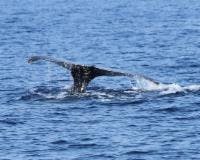Not Floundering

March 1. 2024
Aloha,
Our Leap Year Mid-Morning Whale Watch Cruise began with some heavy-duty searching. The first spout we saw was from a Humpback at least 1000 yards from us. But before we could get to him, we saw spouts from a calf and his Momma, so we decided to stop and watch them for awhile. These two were on the surface a lot — and there might have been an Escort with them too. We saw adult flukes several times. but never at the same time. And since we weren’t seeing the underside of these whales’ flukes, we couldn’t say for sure if we were looking at two whales with different fluke patterns or one whale who kept showing her flukes at different angles. A couple of times, these whales surfaced really close to us (30 feet or so) – of course while that was happening the boat wasn’t in gear . Oh, and while we were watching these close-by Humpbacks, we saw a few breaches from other Humpbacks about a half mile away, but we didn’t have time to investigate.
Mahalo,
Claire
Ocean Sports Whale Fact of the Day: On today’s Whale Watch we saw flukes so often that we started thinking about the etymology of the word “fluke”. We know that the triangular tip of an anchor is called a fluke, and since a whale’s tail sort of resembles an anchor, that made sense. But why would we call a weird occurrence a “fluke”? So I looked it up…”fluke” comes from the German word “flugel” which means wing (that makes sense, because a whale’s tail looks a little like a wing). The phrase “just a fluke” is of unknown origin, but it was first used to describe a lucky shot in billiards. Since there’s a fish also called a “fluke” — it’s a flounder — the phrase might have come about as a pun on “floundering” In other words, if you “make a fluke”, you’re just floundering, and your success is merely due to luck.
